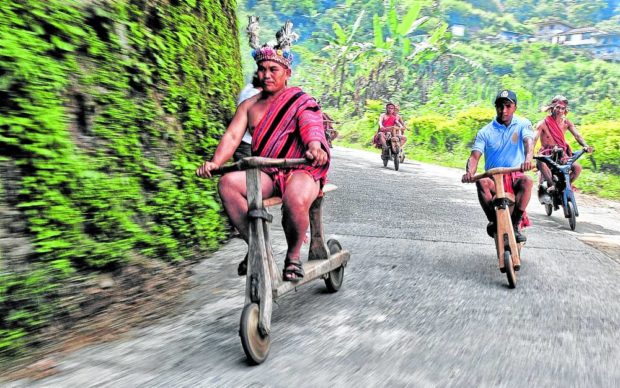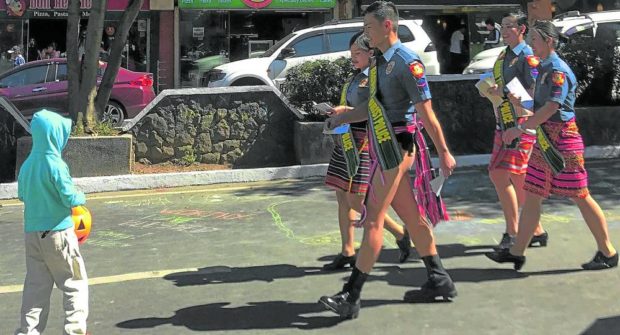Cordillera cops shed ‘bahag,’ ‘tapis’ to follow uniform rule

IDENTITY | Policemen in the Cordillera region have been matching their uniforms with their traditional outfits for important community events, like festivals in Ifugao and Mountain Province, to express their identities. In this photo taken in 2014, a tourist cop escorts participants in a community festival at the woodcarving village of Asin on the boundary of Baguio City and Tuba, Benguet. (File photo by EV ESPIRITU / Inquirer Northern Luzon)
BAGUIO CITY, Benguet, Philippines — The last time Cordillera police officers were seen wearing their uniforms with the woven “bahag” (G-string or loincloth) or “tapis” (wraparound skirt) was perhaps in 2019.
Before the COVID-19 pandemic shut down tourism for nearly two years, members of the Baguio Tourism Police were instant social media darlings when they strode around downtown Session Road in their blue uniforms combined with their indigenous Filipino outfits.
They entertained requests from Baguio visitors for “selfies” and chatted with residents, some of whom came from the police officers’ hometowns in the Cordillera.
Now that quarantine restrictions have eased and local economies in the region are on the road to recovery, “bahag cops” will not be returning because the Philippine National Police has reiterated its policy regarding proper general office attire, said Col. Francisco Bulwayan, director of the Baguio City Police Office, at a tourism briefing last week.
“Much as we would like [the Cordilleran police to express their identities], we have an existing policy from our national headquarters called ‘Tamang Bihis’ (proper attire) which prescribes how the uniform must be strictly worn,” said Bulwayan, a native of Kalinga province.
Article continues after this advertisementIdentity
But indigenous communities do not see anything wrong with police wearing bahag or tapis, said professor Jimmy Fong, dean of the College of Arts and Communication at the University of the Philippines Baguio.
Article continues after this advertisement“By expressing their identity through the bahag, police officers are given a sense of place, similar to how the Scottish police wear their ceremonial kilts,” Fong, an Ibaloy, told the Inquirer.
Ifugao policemen wore their bahag with their uniforms in the prepandemic Imbayah, a cultural festival at Banaue town that hosts one of the most visited rice terraces in the province.
Police officers serving the Mountain Province capital of Bontoc also wear bahag and tapis during their Lang-ay festival, which is held in January.
Some critics have described policemen in bahag as a tourism stunt as the attire elicited comments and jokes about how these would make chasing after crooks impossible during big gatherings.
“The tapis is so thick that policewomen would likely have a difficult time maneuvering,” conceded lawyer Atanacio Addog, Cordillera director of the National Commission on Indigenous Peoples.

TOURIST POLICE | Baguio Tourism Police officers, in this photo in 2019, patrol Session Road in their “bahag” (G-string) and “tapis” (wraparound skirt) to provide any assistance to residents and tourists in the summer capital. (File photo by VINCENT CABREZA / Inquirer Northern Luzon)
‘Our normal’
But matching bahag and tapis with a conventional wardrobe has been around since the early 1900s, he said.
“I remember an elderly relative in Besao, Mountain Province, who still came out on Sundays in an ‘amerikana’ (suit and tie) and his bahag in the 1980s,” Addog said.
Archival photographs of old Cordilleran wearing suits and bahag have been ridiculed back in the early 1900s, but Addog said “the bahag was our everyday wear” in the Cordillera before and during the country’s colonization.
“Wearing the bahag was our normal,” he said, noting that the suits donated by Americans in the process of assimilating the Igorots in the 1900s were the unusual items “which our great grandparents and grandparents were trying out at the time they were photographed.”
Prominent politicians like Alfredo Lamen wore a suit and bahag during official functions when he served as congressman of the original Mountain Province (composed of Benguet, the current Mountain Province, the former Kalinga-Apayao and Ifugao) during the 1960s.
Former Baguio Mayor Mauricio Domogan often attended ceremonies in a bahag while former lawmaker and Ifugao Gov. Teodoro Baguilat Jr. showed up in a bahag in several campaign rallies when he ran for senator in this year’s elections.
“What has been important for [Cordilleran observers] was that these police officers wore their bahag and tapis properly,” Addog said.
RELATED STORIES
NCIP calls out pageant organizers over supposed misuse of ‘bahag’
IP scholars seek protection of Cordillera rites in festivals